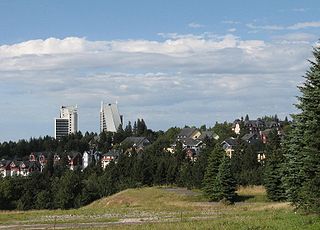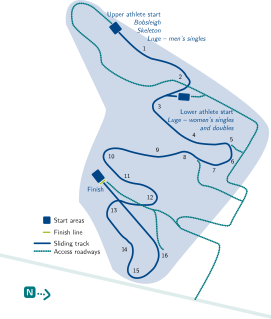| Medal record | ||
|---|---|---|
| Luge | ||
| European Championships | ||
| 1937 Oslo | Men's singles | |
Harald Seegard was a Norwegian luger who competed during the 1930s. He won the silver medal in the men's singles event at the 1937 European luge championships in Oslo, Norway.
| Medal record | ||
|---|---|---|
| Luge | ||
| European Championships | ||
| 1937 Oslo | Men's singles | |
Harald Seegard was a Norwegian luger who competed during the 1930s. He won the silver medal in the men's singles event at the 1937 European luge championships in Oslo, Norway.

A luge is a small one- or two-person sled on which one sleds supine and feet-first. A luger steers by using their calf muscles to flex the sled's runners or by exerting opposite shoulder pressure to the seat. Racing sleds weigh 21–25 kg (46–55 lb) for singles and 25–30 kg (55–66 lb) for doubles. Luge is also the name of an Olympic sport.

Sledding, sledging or sleighing is a winter sport typically carried out in a prone or seated position on a vehicle generically known as a sled, a sledge (British), or a sleigh. It is the basis of three Olympic sports: luge, skeleton and bobsledding. When practised on sand, it is known as a form of sandboarding. In Russia sledges are used for maritime activities including fishing and commuting from island to island

Oberhof is a town in the Schmalkalden-Meiningen district of Thuringia, Germany. It is a winter sports center and health resort. With 1,625 inhabitants, it is visited by 144,000 tourists every year (2016). The town got its official city status in 1985.

Korketrekkeren is a tobogganing track and former bobsleigh and luge track in Oslo, Norway. The tobogganing track runs between Frognerseteren and Midtstuen and is operated as a public venue by the municipality. Return transport to the top of the hill is undertaken by riding the Oslo Metro's Holmenkollen Line. Tobogganing in the area started in the 1880s, with several roads being used during winter evenings. Auto racing took place in the hill in 1921 and the following year it saw its first luge tournament. The first major tournament was the FIL European Luge Championships 1937. Tobagganing also took place in the nearby Heftyebakken, but from 1950 Korketrekkeren became the sole tobogganing hill and Heftyebakken was used for cross-country skiing.

The FIL World Luge Championships, part of the International Luge Federation (FIL) have taken place on an almost annual basis in non-Winter Olympics years since 1955. These championships are shown for artificial tracks. See FIL World Luge Natural Track Championships for all natural track events that have taken place since 1979.
The FIL European Luge Championships, part of the International Luge Federation (FIL) have taken place since 1914. From 1914 to 1934, these championships were part of the Internationaler Schlittensportsverband. From 1935 to 1956, the championships were held under the auspices of the Fédération Internationale de Bobsleigh et de Tobogganing. Since 1962, the event has been under the auspices of the FIL and has been held in even-numbered years since 1980. Since 2012, it is held annually.
Titti Astri Maartmann was a Norwegian luger who competed in the late 1930s. She won a gold medal in the women's singles event at the 1937 European luge championships in Oslo, Norway. Living an active life, she still played golf at age 97.

The International Luge Federation is the main international federation for all luge sports. Founded by 13 nations at Davos, Switzerland in 1957, it has members of 53 national luge associations as of 2009 and is based in Berchtesgaden, Germany.
The FIL World Luge Championships 1955 took place in Oslo, Norway under the auspices of the Fédération Internationale de Bobsleigh et de Tobogganing under their "Section de Luge". It would be the only world championship under the FIBT until formation of the International Luge Federation (FIL) in 1957.

The FIL European Luge Championships 1937 took place in February 1937 at Korketrekkeren in Oslo, Norway under the auspices of the Fédération Internationale de Bobsleigh et de Tobogganing under their "Section de Luge", a trend that would continue until the International Luge Federation (FIL) was formed in 1957.
The FIL European Luge Championships 1954 took place in Davos, Switzerland under the auspices of the Fédération Internationale de Bobsleigh et de Tobogganing under their "Section de Luge", a trend that would continue until the International Luge Federation (FIL) was formed in 1957. An American delegation participated in this event, giving way to the creation of the first World luge championships that would be organized the following year in Oslo, Norway.
The FIL European Luge Championships 1976 took place in Hammarstrand, Sweden for the second time after previously hosted the championships in 1970. A record five countries won medals at these championships, breaking the previous record set in 1971 that was equalled in 1974.
Paul Hildgartner is an Italian luger who competed from the early 1970s to the late 1980s. Competing in five Winter Olympics, he earned two gold medals and one silver medal for his efforts. At the 1984 Winter Olympics, Hildgartner carried the Italian flag during the opening ceremonies.
Karla Kienzl was an Austrian luger who competed during the 1950s. She won the gold medal in the women's singles event at the 1955 FIL World Luge Championships in Oslo, Norway. Kienzl was the first World champion in luge in this event.
Vilhelm Klavenæs was a Norwegian luger who competed during the 1930s. He won the silver medal in the men's singles event at the 1937 European luge championships in Oslo, Norway.
Liv Jensen was a Norwegian luger who competed in the late 1930s. She won a silver medal in the women's singles event at the 1937 European luge championships in Oslo, Norway.

The FIL World Luge Championships 2009 ran on 1–8 February 2009 at the bobsleigh, luge, and skeleton track in Lake Placid, New York, United States for the second time after having hosted the event in 1983. They were awarded the event at the 2006 FIL Congress in Berchtesgaden, Germany.

Lillehammer Olympic Bobsleigh and Luge Track is a bobsleigh, luge and skeleton track located at Hunderfossen in Lillehammer, Norway, 15 kilometers (9 mi) north of the town center of Lillehammer. It was completed in 1992 for the 1994 Winter Olympics, where it hosted the bobsleigh events and luge events. It has since also hosted the FIBT World Championships 1995 in skeleton and the FIL World Luge Championships 1995, and hosted 2016 Winter Youth Olympics.
The 2013–14 Luge World Cup was a multi race tournament over a season for luge organised by the FIL. The season started on 16 November 2013 in Lillehammer, Norway and ended on 26 January 2014 in Sigulda, Latvia. After the World Cup, the athletes moved for two weeks to Sochi for the Luge event in the XXII Olympic Winter Games.
The 2020 FIL European Luge Championships were held from 18 to 19 January 2020 in Lillehammer, Norway.
| This biographical article relating to luge in Norway is a stub. You can help Wikipedia by expanding it. |